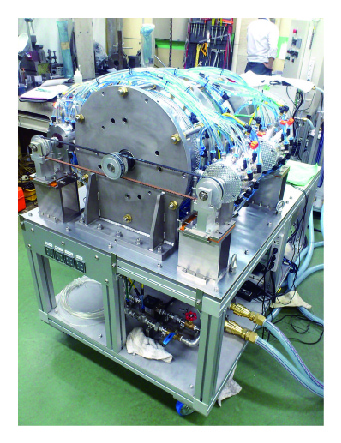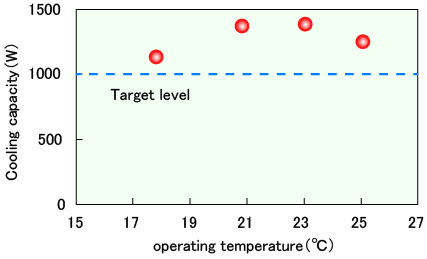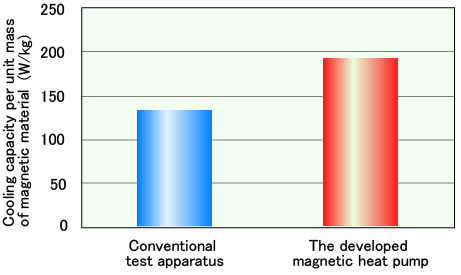6. Magnetic heat pump system for non-Freon air-conditioners
- A magnetic heat pump with a cooling capacity of 1.4 kW was developed using gadolinium alloy as magnetic material.
Magnetic heat pumps differ from conventional refrigeration which compresses or expands chlorofluorocarbon (CFC) or Hydro Chloro Fluoro Carbon (HCFC) gas. Refrigeration technology using magnetic heat pumps exploits the magnetocaloric effect produced when a magnetic field is generated using magnetic material. HCFCs are scheduled to be completely abolished by 2020. As a result, urgent research is being undertaken into natural refrigerants and new refrigeration technology. Compared to conventional vapor refrigeration, magnetic refrigeration has a more efficient cycle, offering energy savings . In addition, since magnetic refrigeration does not use CFCs or HCFCs, there is no need for a compressor, reducing noise and vibrations . Given these features, it is hoped that this technology will be used in future air conditioning units and refrigerators.
There are still only few heat pumps with a kW level cooling capacity around the world, and, none had been developed in Japan. In this instance, in order to generate a kW level cooling capacity the Halbach arrayed permanent magnet developed at RTRI was incorporated into a new heat pump design, including gadolinium alloy as the magnetic material (Fig.1). Cooling capacity test were conducted at room temperature, and a cooling capacity of 1.4 kW was obtained, exceeding the target of 1 kW (Fig.2). The newly developed magnetic heat pump system, compared with conventional test refrigerators has a higher cooling capacity per unit of magnetic material which can be useful for obtaining a more compact design (Fig.3). Results from the present study indicate the potential for this magnetic heat pump technology using the magnetocaloric effect, to be scaled up for use on large refrigerators or cooling equipment. Future research will concentrate on improving refrigeration efficiency, and reducing size and weight of the refrigerator itself so that the technology can be adapted for use on train air conditioning units.

Fig.1 The developed magnetic heat pump
Fig.2 Cooling capacity as a function of operating temperature
Fig.3 Cooling capacity per unit mass of magnetic material